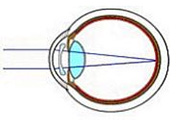
Myopia
Myopia is a sight alteration produced by a focussing disorder which gives rise to blurred images when looking at a distant object. In a myopic eye images coming from the outside world are focussed in front of the retina, therefore the image that is captured is not sharp. The causes resides either in the eye having a larger than normal longitudinal diameter, or the focussing power of the cornea and the crystalline lens being excessively strong.
In most cases myopia is predetermined by genetic factors; it is detected during childhood, it evolves and then tends to stabilise during adulthood.
How it is treated?
Myopia can be treated using glasses, contact lenses or with intraocular surgery.
Myopia in detail
Our centres offer you the most modern and effective techniques for correcting myopia.
The decision as to the most suitable technique for each case is based on an ophthalmologic study carried out by our experts.
Below we have an explanation of the different possibilities that exist for correcting myopia.

- The rays of light penetrate into the inside of the eye through the cornea. The crystalline lens is a lens that concentrates these rays to form an image on the retina. In the emmetrope (normal) eye a sharp image is formed.

- Myopia is a refractive defect that causes the image to form in front of the retina. It is normally due to the eye being longer than normal. The result is a blurred image.

- Myopia can be corrected by means of a lens that causes a divergent deviation of the light rays. This enables a sharp image to be formed on the retina.

- Laser surgical techniques consist of modifying the curvature of the cornea. The laser eliminates a microscopic layer of corneal tissue to produce the same effect as the lens needed to correct the eye's refractive defect.

- In cases where laser correction of a refractive defect is not appropriate, it is possible to resort to implanting a lens inside the eye, in front of the crystalline lens. These are called aphakic lenses.

- If the patient is nearing an age when cataracts appear, he may opt for replacing the crystalline for another lens.
